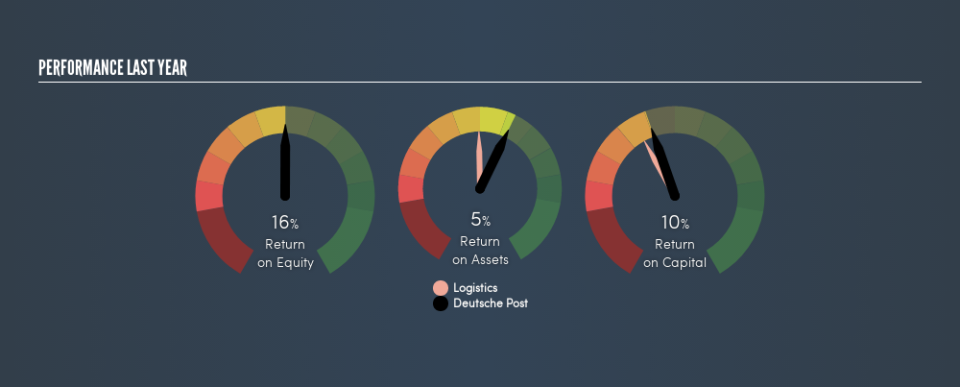Shareholders Should Look Hard At Deutsche Post AG’s (ETR:DPW) 9.7% Return On Capital

Want to participate in a research study? Help shape the future of investing tools and earn a $60 gift card!
Today we are going to look at Deutsche Post AG (ETR:DPW) to see whether it might be an attractive investment prospect. In particular, we’ll consider its Return On Capital Employed (ROCE), as that can give us insight into how profitably the company is able to employ capital in its business.
First, we’ll go over how we calculate ROCE. Then we’ll compare its ROCE to similar companies. And finally, we’ll look at how its current liabilities are impacting its ROCE.
Return On Capital Employed (ROCE): What is it?
ROCE is a metric for evaluating how much pre-tax income (in percentage terms) a company earns on the capital invested in its business. All else being equal, a better business will have a higher ROCE. Ultimately, it is a useful but imperfect metric. Author Edwin Whiting says to be careful when comparing the ROCE of different businesses, since ‘No two businesses are exactly alike.’
How Do You Calculate Return On Capital Employed?
Analysts use this formula to calculate return on capital employed:
Return on Capital Employed = Earnings Before Interest and Tax (EBIT) ÷ (Total Assets – Current Liabilities)
Or for Deutsche Post:
0.097 = €3.3b ÷ (€50b – €16b) (Based on the trailing twelve months to December 2018.)
Therefore, Deutsche Post has an ROCE of 9.7%.
View our latest analysis for Deutsche Post
Does Deutsche Post Have A Good ROCE?
ROCE can be useful when making comparisons, such as between similar companies. We can see Deutsche Post’s ROCE is meaningfully below the Logistics industry average of 14%. This performance could be negative if sustained, as it suggests the business may underperform its industry. Regardless of where Deutsche Post sits next to its industry, its ROCE in absolute terms appears satisfactory, and this company could be worth a closer look.
When considering this metric, keep in mind that it is backwards looking, and not necessarily predictive. Companies in cyclical industries can be difficult to understand using ROCE, as returns typically look high during boom times, and low during busts. ROCE is only a point-in-time measure. What happens in the future is pretty important for investors, so we have prepared a free report on analyst forecasts for Deutsche Post.
How Deutsche Post’s Current Liabilities Impact Its ROCE
Liabilities, such as supplier bills and bank overdrafts, are referred to as current liabilities if they need to be paid within 12 months. The ROCE equation subtracts current liabilities from capital employed, so a company with a lot of current liabilities appears to have less capital employed, and a higher ROCE than otherwise. To counter this, investors can check if a company has high current liabilities relative to total assets.
Deutsche Post has total liabilities of €16b and total assets of €50b. Therefore its current liabilities are equivalent to approximately 33% of its total assets. With this level of current liabilities, Deutsche Post’s ROCE is boosted somewhat.
Our Take On Deutsche Post’s ROCE
While its ROCE looks good, it’s worth remembering that the current liabilities are making the business look better. Of course, you might find a fantastic investment by looking at a few good candidates. So take a peek at this free list of companies with modest (or no) debt, trading on a P/E below 20.
If you like to buy stocks alongside management, then you might just love this free list of companies. (Hint: insiders have been buying them).
We aim to bring you long-term focused research analysis driven by fundamental data. Note that our analysis may not factor in the latest price-sensitive company announcements or qualitative material.
If you spot an error that warrants correction, please contact the editor at editorial-team@simplywallst.com. This article by Simply Wall St is general in nature. It does not constitute a recommendation to buy or sell any stock, and does not take account of your objectives, or your financial situation. Simply Wall St has no position in the stocks mentioned. Thank you for reading.

 Yahoo Finance
Yahoo Finance 
